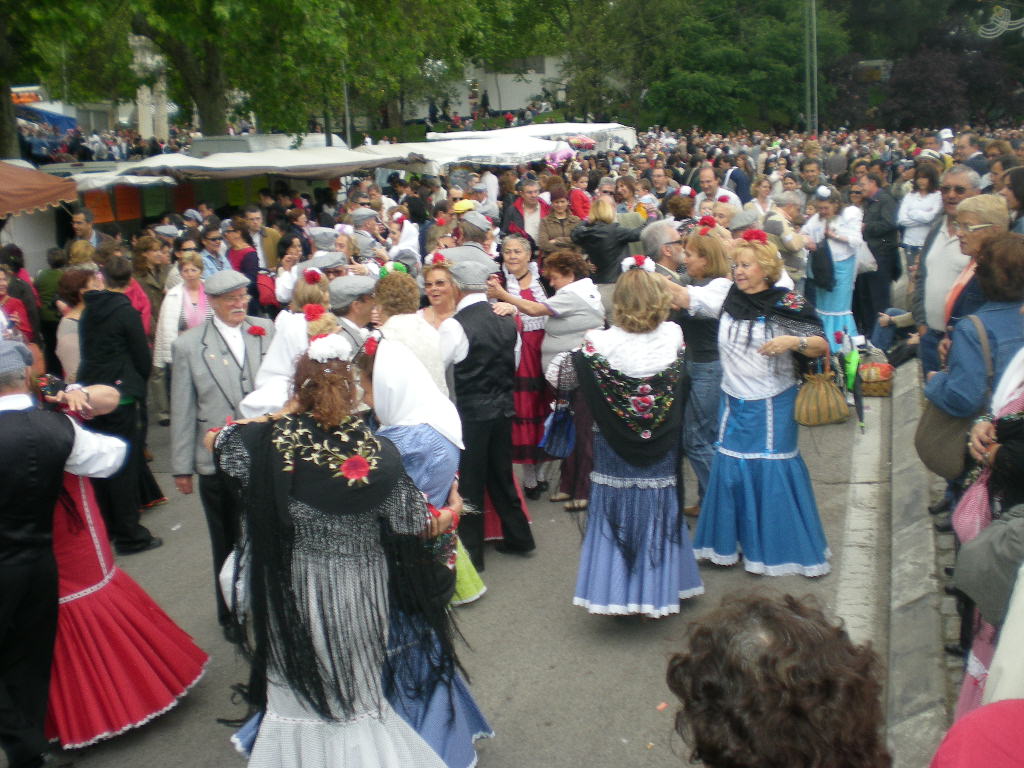
With the arrival of spring and the long awaited festival of San Isidro, the patrón saint of the capital, Madrid takes to the streets to intensely experience one of the city's best times of the year. Gastronomy is yet another attraction of this festive period in which celebrations are unthinkable if not accompanied by the delicious, traditional Madrid cuisine.
There are many dishes that have been associated for decades with the San Isidro festivity, perhaps as it is the moment when pride in traditional Madrid cuisine and its age-old recipes get to shine. A cuisine that is overshadowed the rest of the year, eclipsed perhaps by the rich and diverse culinary offerings to be had in the capital, which allows us to enjoy all of the cuisines of the world without leaving Madrid.
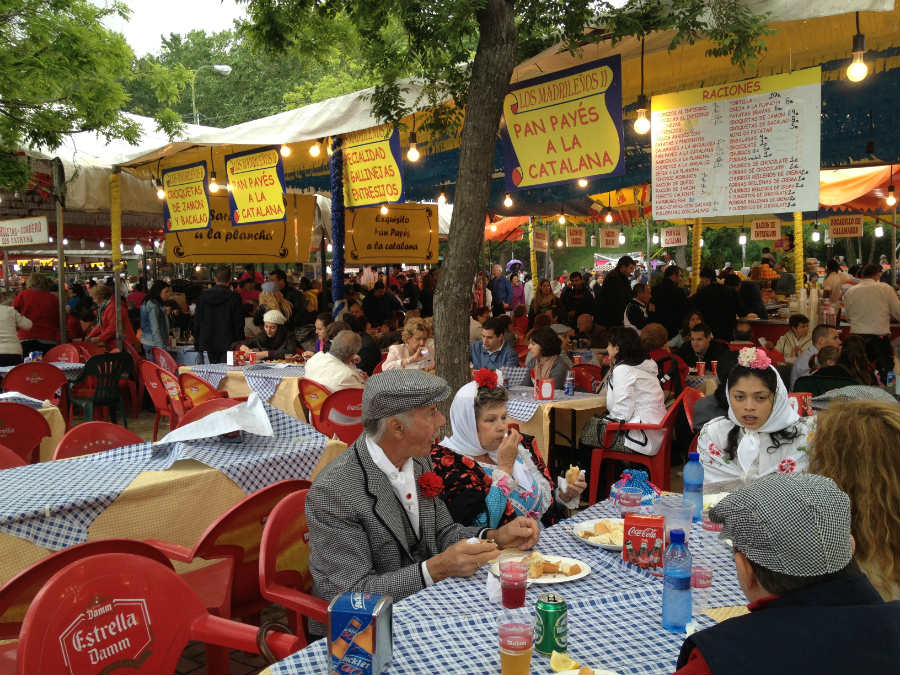
Very shortly traditional cuisine takes centre stage and we can enjoy classic Madrid stew and a hearty helping of tripe in many restaurants. Without these dishes, the gastronomy of a whole region could not be understood. Curiously, neither of the dishes is originally from Madrid, although it is true that Madrid has stamped its character on them.
Together with stews and hotpots, there are delicious types of fish, bream done in Madrid style being one worth mentioning. Natives of Madrid are experts on and big fans of seafood as if they lived in a port. That is almost the case, as Madrid receives produce from almost all the ports in Spain every day and knows how to cook these products with real expertise. Hake, gilthead bream and seabass are sold every morning in all of the markets in Madrid, as are all types of shellfish.
At this time of year, meat lovers will also see their needs met as dishes made with ox meats abound in taverns and restaurants.The San Isidro Fair takes all of the ox meat from the bullfights to the market, with which excellent stews, oxtail hotpots, grilled sirloins and fillet streak are prepared.
With the arrival of the festival, spring officially opens in Madrid and its streets fill up with terraces where all of its gastronomic offerings can be enjoyed outdoors. The centre of Madrid fills up every lunchtime with lovers of tapas and the most traditional cuisine.
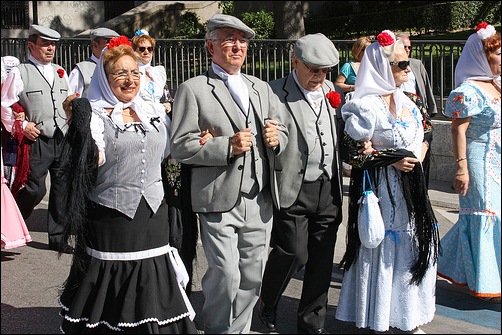
The Puerta del Sol, Opera and la Latina make up the most “culinary” triangle of Old Madrid, where it is worth losing yourself in its back streets to discover places like El Viajero de la Latina, El Nuncio, la Terraza del Platería, El Espejo de Recoletos, la Taberna del Alabardero and El Café de Oriente, among many others. There is varied fare, particularly as regards tapas. The most traditional ones are prawns cooked with garlic or deep-fried, steamed mussels, anchovies in vinegar, pickled tuna, croquettes, tortilla and little tripe stews. To wash it all down, the traditional vermouth or local wine.
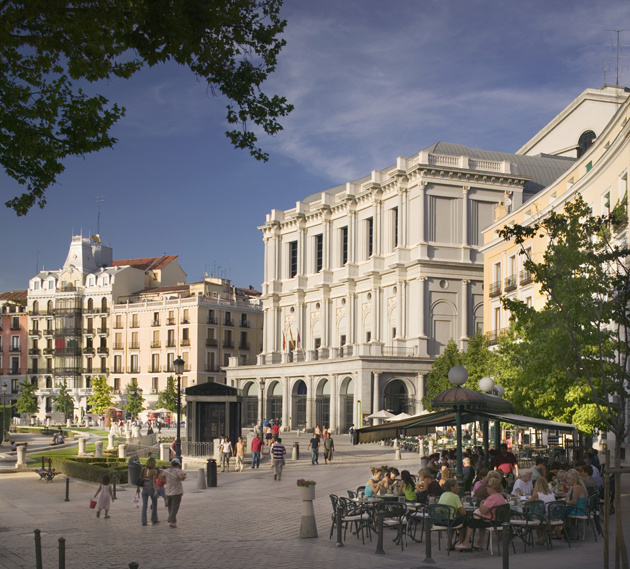
Madrid celebrates the Fiestas de San Isidro for 9 days, from the Friday before May 15 through to the following Sunday. It's the most important, lively and emblematic Madrid festival of the year.
San Isidro was canonized on May 15, 1622, for miraculously making water rise to rescue his son from a well, along with a handful of other wondrous deeds. Hence he became Madrid's patron saint and, simultaneously, the "labourer/peasant saint" after his profession.
One can visit the church of the same name (San Isidro) on Calle Toledo - built over the site where the miracle purportedly took place - about two blocks from the Plaza Mayor. The church holds a small museum with exhibits including the famous well along with a small collection of archaeological findings excavated in the region of Madrid.
Like most in Spain, this Madrid festival has largely lost its religious character. Instead, the city government uses San Isidro as a platform to represent the best of Madrid culture, old and new, from bullfights to break dancing. You'll enjoy a full calendar of concerts, plays, parades, fairs and special art exhibits, most free of charge.
Weekend partying is centred day and night around the Plaza de las Vistillas, Plaza de San Andrés and Puente de Segovia in the Austrias neighbourhood, near the Plaza Mayor. At night, bars set up shop on the street, or "chiringuitos."
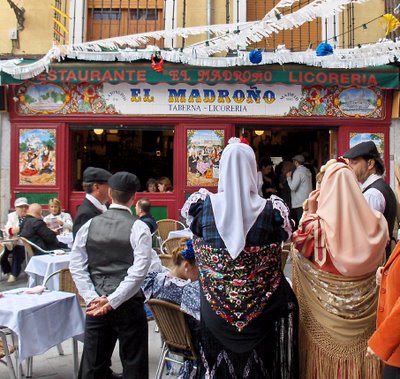 The Chotis is Madrid's typical music and dance, though strangely Scottish in origin. It became popular in the 19th century and was largely danced in the working class neighbourhoods of Lavapiés and El Rastro. Those who lived in these areas did not have much money, but they dressed and danced brightly as if they did. Known as "majos" and "majas," or "chulapos" and "chulapas" (a variation of "chulo," which means cool or cocky), Goya immortalized these proud, attractive madrileños in numerous paintings which you can see at the Prado Museum.
The Chotis is Madrid's typical music and dance, though strangely Scottish in origin. It became popular in the 19th century and was largely danced in the working class neighbourhoods of Lavapiés and El Rastro. Those who lived in these areas did not have much money, but they dressed and danced brightly as if they did. Known as "majos" and "majas," or "chulapos" and "chulapas" (a variation of "chulo," which means cool or cocky), Goya immortalized these proud, attractive madrileños in numerous paintings which you can see at the Prado Museum.
"Castizo" is an adjective that describes anything typical of Madrid. Thus the "castizo" madrileños of today dress up like chulapos/as and dance the chotis or head down to the San Isidro Hermitage on the banks of the Manzanares River to eat cocido, a local kind of stew.
Gigants (people on stilts) with "cabezudos" (big, satirical papier mache heads) parade around the city center, usually on the first Saturday afternoon of San Isidro.
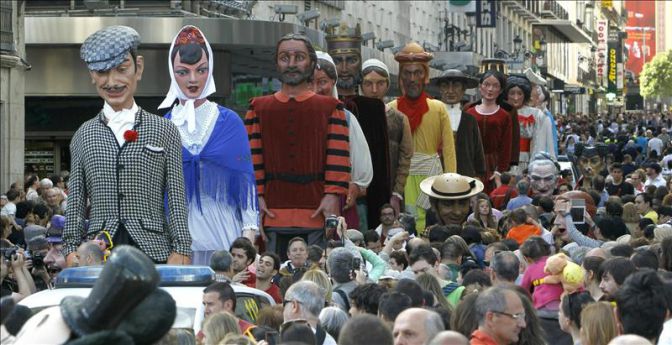
You can buy barquillos all year round in front of the Palacio Real, but they are especially prevalent during San Isidro. Barquillos are wafers topped with chocolate or whipped cream to your liking. The vendors, called "barquilleros" dress like "chulapos" with a traditional vest and cap and carry around a "wheel of fortune" where you can gamble for more wafers.
So if you happen to be near Madrid this month, pop in and enjoy the Fair!